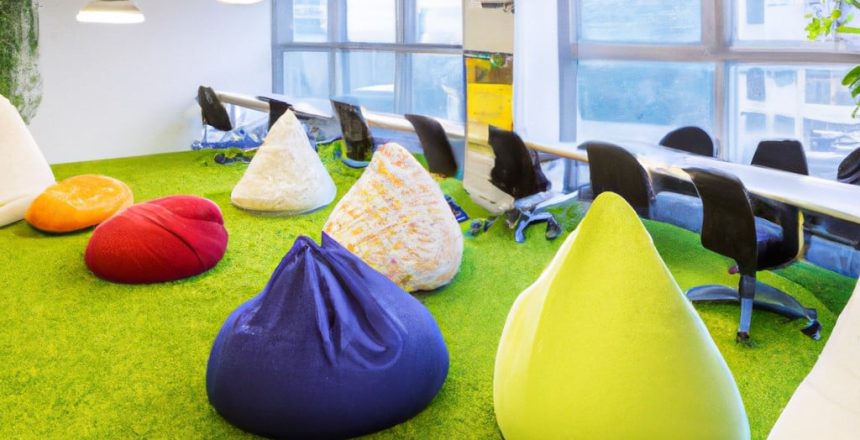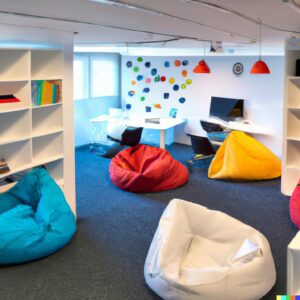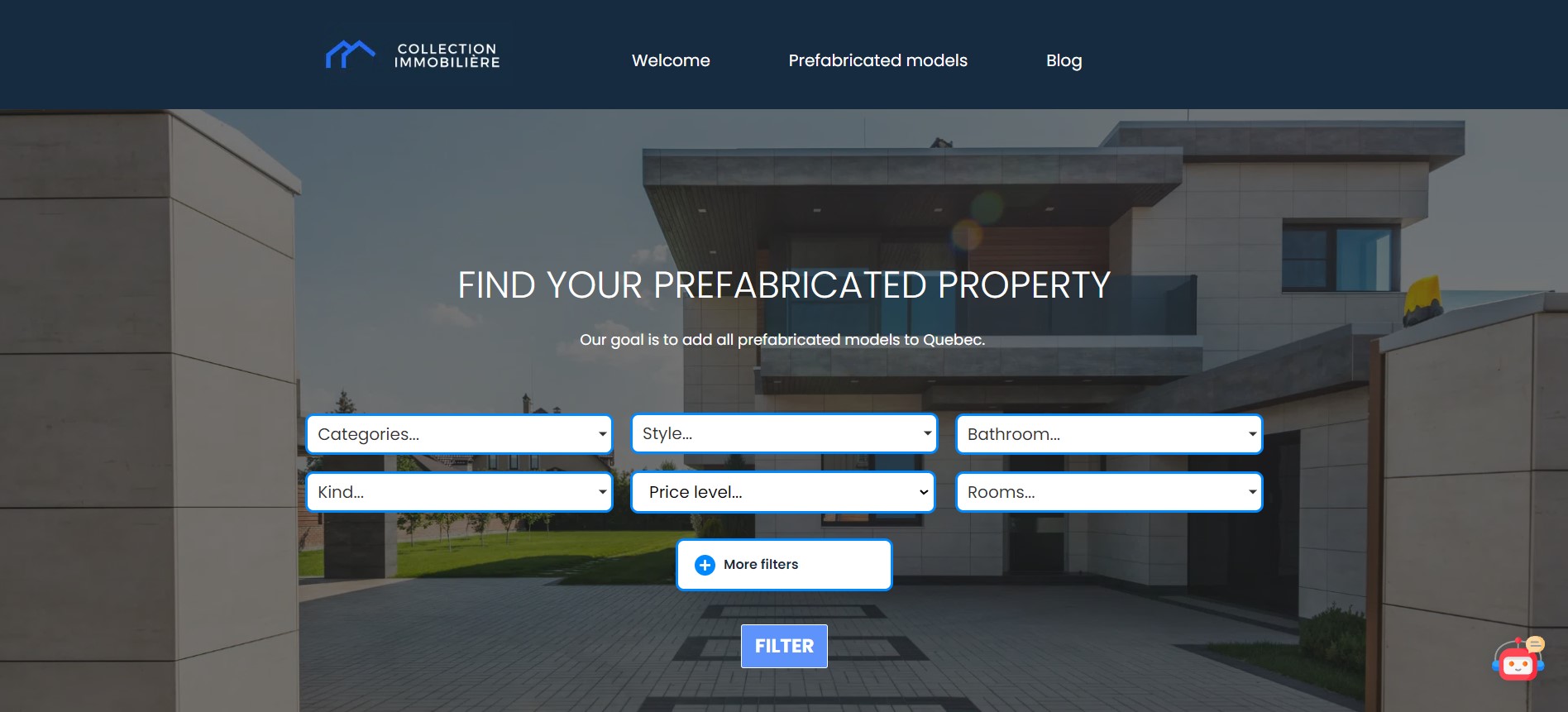Whether it’s a Fortune 500 company or a SME — whether it’s to stay ahead, or to get ahead of competition — or whether in product design or in problem solving, creativity is the spark businesses need for innovation and progress. As an old telling states, we are the product of our envirement, and so are our ideas and solutions.
In a forever more competitive world like ours, this is where creative spaces in businesses makes sense. We need to optimize the work envirement of our teams so that they can be at their best. As you go through this article, you will understand the multiple benefits of having a great creative space in your business. We will also go through the must have and must do of putting toghether a creative room to maximise team’s creativity and cheerfulness.
What is a Creative Space Exactly?
A creative space often referred to as a creative room in businesses, is a specially designed space to foster creativity, interactions, and clarity of thoughts for teams or individuals. It typically provides some flexible workspaces and the necessary material and tools to achieve work such as brainstorming sessions, reunions, and team projects.
Creative spaces in offices started to gain popularity in early 2000, as companies like Google and Microsoft were experimenting with collaborative workspace. Since then they’ve pioneered the craft and the popularity of creative space grow as more and more businesses recognize the value that they bring.
Watch the tour of Google headquarters filled with creative spaces and flexible workspace.
Proven Benefits of a Creative Spaces in Business
There are many benefits to creating spaces in the workplace. some of which have been proven through research. Here are the top benefits you get from having a creative workspace in your offices.
- Increased Creativity and Productivity: Creative spaces are designed to help employees get in a creative and productive state of mind. A study by the Harvard Business Review found that companies with more collaborative workspaces saw a boost in productivity by an average of 32%.Another study by the university of Exeter found that employees who have access to natural light in the office reported a 15% increase in creativity. Two examples of how our environment can influence us. Those two significant increases would translate into more innovative ideas and ultimately an increased success rate in problem-solving.
- Improved Collaboration: Open floor plans and shared workspaces make it easier for employees to work together and share ideas. This can lead to more efficient problem-solving and faster project completion. Additionally, studies have shown that employees who have access to shared spaces report higher levels of job satisfaction and improved team cohesion.
- Employee Morale: A study by the University of California found that employees who have a say in the design of their workspace reported higher levels of job satisfaction and felt more connected to their company. Additionally, access to natural light and plants in the workplace has been shown to improve employee well-being and reduce stress levels.
Ultimately, incorporating a creative space in business can also have a positive impact on the company’s bottom line. A study by the University of Sydney found that businesses that invest in employee well-being through design and amenities can see a return on investment of up to $6 for every $1 spent.
Plus, in the context of labor shortage, businesses need to create an environment and culture that attract people, retains them, and brings out the best in them.
How do I Create a Creative Space in my Offices?
Creating a creative space in an office that fosters creativity, collaboration, and clarity of thought requires a combination of different design elements. Here are a few key considerations to keep in mind when designing a creative space:
Flexible Workspace
One of the key elements of a creative space in business is flexibility. Employees should be able to adjust their workstations to suit their needs, whether that means standing, sitting, or working in a more relaxed position. Providing adjustable desks and chairs, as well as a variety of seating options (such as beanbags, couches, etc.) can help to create a more flexible workspace.
Natural Light
Studies have shown that access to natural light can improve employee well-being and reduce stress levels. Make sure that the creative space receives plenty of natural light, and consider adding plants to the area to enhance the positive effects of natural light.
According to Dr. Pragya Agarwal in a Forbes article, often just 13-15 mins of exposure to natural light is enough to trigger the release of endorphins or “happy hormones.“
Alternative Lights
Lighting has a significant impact on the atmosphere and energy of a creative space. The use of LED strips lights and other types of lighting can help to spark creativity in several strips lights are highly versatile and can be used to create a variety of different lighting effects. They can be used to highlight specific areas of a room, create interesting shadows, or change the mood of a space.
Different color temperatures of light can affect the human body in different ways. Warmer colors (such as yellow and orange) can create a cozy and comfortable atmosphere, while cooler colors (such as blue and white) can be energizing and invigorating. By using LED strips lightship can adjust the color temperature of a space to match the activity or the desired mood.
LED strips lights can be used to mimic natural light, which can have a positive effect on employee well-being and reduce stress levels. By using LED strips lighstript mimic the color temperature and brightness of natural light, you can create a space that feels more like the outdoors.
Collaboration
Encourage collaboration by creating spaces for group brainstorming, meetings, and informal gatherings. These spaces should be designed to be comfortable and welcoming, with plenty of seating and writable surfaces.
Personalization
Allowing employees to personalize their workspaces can make them feel more connected to the company and lead to higher levels of job satisfaction. Encourage employees to bring in personal items, such as photographs and plants, to make the space feel more like their own.
Color and Art
Introduce color and art to the space to make it more visually appealing. Bright colors and bold patterns can inspire creativity and help to create a more positive and energizing environment.
Comfort
Make sure that the space is comfortable, with good air circulation, temperature control, and ergonomic furniture to help reduce fatigue and discomfort.
Storage
Make sure that the space has enough storage for all the materials and equipment that employees need to do their work so that the area remains uncluttered and easy to navigate. This is crucial to keep a clear mind and facilitate
It’s important to keep in mind that a creative space in business should be tailored to the specific needs of the company and its employees. The key is to create an environment that is comfortable, flexible, and conducive to creativity and collaboration.
What are examples of creative activities?
it’s more important than ever for companies to foster creativity and innovation. A dedicated creative space can provide the ideal environment for employees to come together and generate new ideas. In this article, we’ll explore a few different creative activities and concepts that can be implemented in the creative space of a manufacturing business, such as Design Thinking, Innovation workshops, Rapid prototyping, Mind mapping and Role-playing.
These activities not only promote creativity and innovation but also helps employees to practice their communication and problem-solving skills, and to identify areas for improvement. So, let’s dive in and see how these activities can help a manufacturing business to stay ahead of the curve.
Design Thinking: Design thinking is a problem-solving approach that encourages creativity and innovation. It involves understanding the user’s needs, prototyping and testing different solutions, and iterating until the best solution is found. This approach can be used in manufacturing businesses to come up with new product designs, improve production processes, and find ways to reduce costs.
Innovation workshops: Innovation workshops are a great way to generate new ideas and encourage collaboration among employees. These workshops can be used to brainstorm new products, processes or services, and identify areas for improvement. The creative space can be used as a dedicated area for these workshops, where employees can come together and work on projects in a relaxed and focused environment.
Rapid prototyping: Rapid prototyping is a process of quickly creating a physical or digital model of a product or design. This can be done using 3D printing, laser cutting, or other digital fabrication techniques. Rapid prototyping is a great way to test new ideas and get feedback on designs. The creative space can be equipped with the necessary tools and technology to enable employees to quickly prototype their ideas.
Mind mapping: Mind mapping is a technique that can be used to visually organize ideas and relationships between different concepts. This can be a useful tool for employees in a manufacturing business to brainstorm new ideas and identify potential solutions to problems.
Role-playing: Role-playing is a technique that can be used to simulate real-life scenarios, such as customer interactions or business negotiations. This can be a useful tool for employees to practice their communication and problem-solving skills, and to identify areas for improvement.
These are just a few examples of creative activities and concepts that can be implemented in the creative space of a manufacturing business. The key is to provide employees with the resources and support they need to be creative, and to create an environment that fosters collaboration and innovation.
Bibliographic Sources :
- This blog post was written with the assistance of an AI language model, specifically ChatGPT. While the model generated the initial content, it has been extensively revised, edited, and fact-checked by the author to ensure accuracy and compliance with Google’s guidelines. The author takes full responsibility for the final product and any errors or inaccuracies that may remain.
- Dr. Pragya Agarwal. “How Does Lighting Affect Mental Health In The Workplace“ December 2018, FORBES.










